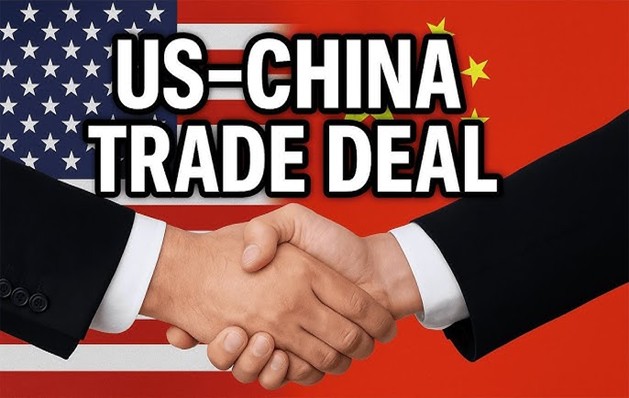US-China Trade Deal: Challenges, Risks, and Future Prospects
US-China Trade Deal: Challenges, Risks, and Future Prospects
Syllabus:
GS-2:
Effect of Policies & Politics of Countries on India’s Interests , International Treaties & Agreements , Government Policies & Interventions , India and its Neighbourhood , Important International Institutions
Focus:
The recent announcement of a temporary suspension of tariffs between the US and China has sparked renewed hopes for a trade agreement. However, past experiences and ongoing complexities indicate that a stable, enforceable deal remains uncertain, with potential lasting disruptions to global supply chains and economic relations.
Background of US-China Trade Relations:
Tariffs as Negotiation Tools
- The US, under President Donald Trump, employed tariffs as leverage to pressure China into trade concessions.
- Trump viewed tariffs as a bargaining chip, expecting that escalating trade tensions would force China to concede and produce a political win.
- Unlike simple business deals, trade negotiations, especially between superpowers, are slower, complex, and have broader geopolitical consequences.
China’s Position and National Pride
- China has a large economy with significant leverage in negotiations.
- It resists conceding to demands perceived as humiliating or detrimental to national pride.
- Yielding to aggressive US demands risks domestic backlash in China, making compromise difficult.
- The Chinese proverb, “Once riding a tiger, it is difficult to get off,” aptly describes China’s position in the trade war.
Complexity of Trade Agreements:
Drafting Difficulties
- The US-China trade deal is complicated to draft due to differences in legal and regulatory frameworks.
- The 2019 talks failed as the US wanted a detailed 150-page contract with strict legal reforms, while China preferred a flexible, principle-based
Enforcement Challenges
- The “Phase One” deal signed in January 2020 lacked a neutral enforcement mechanism.
- It relied on mutual compliance, which proved fragile when China missed purchase targets.
- The absence of strong enforcement reduced trust, especially amid political changes in the US.
- As a result, any new deal is likely to be fragile, limited in scope, and prone to collapse.
Impact on Global Supply Chains:
Disruptions and the Bullwhip Effect
- The trade war caused severe disruptions to global supply chains, already fragile and complex.
- Retailers and manufacturers faced uncertainty, leading to canceled orders, stockpiling, and rerouted production.
-
The bullwhip effect describes how small supply chain disruptions cause disproportionately large and lasting impacts.
Case Study: Toy Industry
- For example, US retailers planning for Christmas need to place orders by March for production starting in April.
- Tariff unpredictability causes delays in orders, disrupting manufacturing schedules and shipment timelines.
-
Even lifting tariffs now may not fully restore normal supply because production lines must adjust and reconfigure.
Economic Consequences and Market Instability:
Price Volatility
- Fluctuating tariffs drive retail price increases due to supply shortfalls.
- Higher prices can send confusing signals to suppliers, aggravating problems of oversupply and underproduction.
- This cyclical instability causes significant market volatility, harming businesses and consumers alike.
Comparisons to Pandemic Disruptions
- Similar to the pandemic’s sudden shutdowns causing shortages and gluts, the trade war’s policy-driven turmoil threatens long-term instability.
- Unlike natural crises, this chaos stems from deliberate political decisions, complicating resolution.
Looking Ahead: Outlook and Risks
The Limits of Tariff Diplomacy
- Trump’s unpredictable use of tariffs might have worked in private business, but in global commerce, it breeds chaos.
- Supply chains require certainty and stable policies; bluffing and policy reversals undermine this foundation.
Advice for Stakeholders
- Investors, businesses, and policymakers should prepare for continued disruptions in supply chains.
- Any US-China trade deal is expected to be fragile and short-lived, necessitating caution in economic planning.
-
The long-term consequences of this trade war will reverberate through factories, ports, and retail markets worldwide.
Conclusion:
While the temporary suspension of US-China tariffs brings momentary relief, the deep-rooted challenges of drafting, enforcing, and trusting a comprehensive trade agreement make a durable deal unlikely. The ongoing trade tensions will continue to destabilize global supply chains and markets, with uncertainty likely to persist, demanding cautious approaches from investors and policymakers.
Source: Mint
Mains Practice Question:
Discuss the challenges and economic impacts of the US-China trade war on global supply chains. How do differences in negotiation styles and enforcement mechanisms affect the prospects of a durable trade agreement between the two powers?




